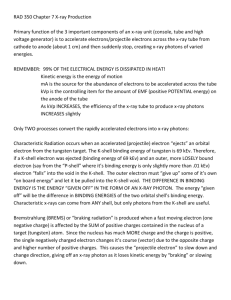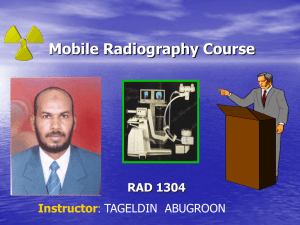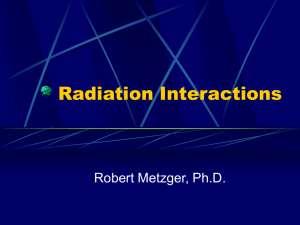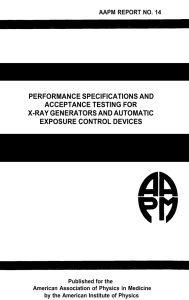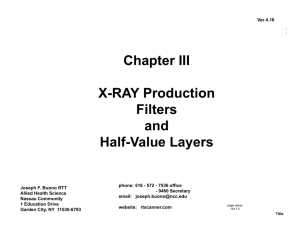respectively ev
advertisement
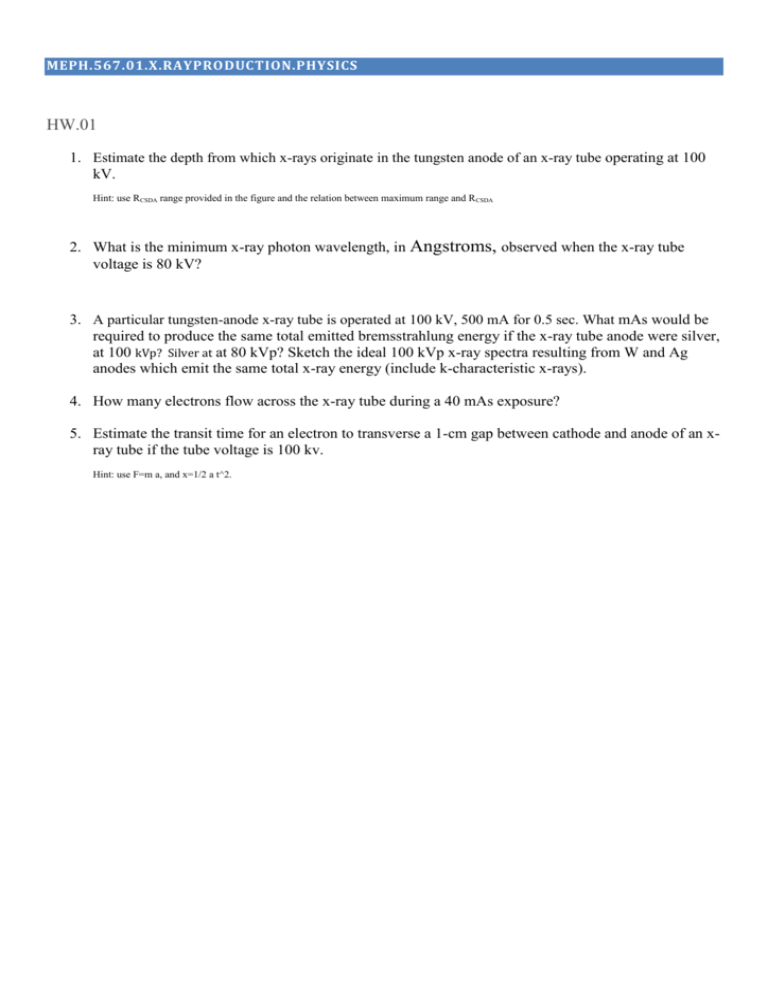
MEPH.567.01.X.RAYPRODUCTION.PHYSICS HW.01 1. Estimate the depth from which x-rays originate in the tungsten anode of an x-ray tube operating at 100 kV. Hint: use RCSDA range provided in the figure and the relation between maximum range and R CSDA 2. What is the minimum x-ray photon wavelength, in Angstroms, observed when the x-ray tube voltage is 80 kV? 3. A particular tungsten-anode x-ray tube is operated at 100 kV, 500 mA for 0.5 sec. What mAs would be required to produce the same total emitted bremsstrahlung energy if the x-ray tube anode were silver, at 100 kVp? Silver at at 80 kVp? Sketch the ideal 100 kVp x-ray spectra resulting from W and Ag anodes which emit the same total x-ray energy (include k-characteristic x-rays). 4. How many electrons flow across the x-ray tube during a 40 mAs exposure? 5. Estimate the transit time for an electron to transverse a 1-cm gap between cathode and anode of an xray tube if the tube voltage is 100 kv. Hint: use F=m a, and x=1/2 a t^2. HW.02: X-RAY BEAM PROPERTIES Most attenuation data required for these problems can be found in the Appendices of Attix. 1. What is the primary beam intensity after an x-ray beam has traveled three mean-free paths into a material? 2. Use data provided in these lecture notes to estimate the density of lung tissue. [Hint: graphs on attenuation and mass attenuation could be used to compute density] 3. One millimeter thick slabs of cadmium (Cd) and Tellurium (Te) are arranged serially as shown. What is the transmission (/o) at 100 keV? The mass attenuation coefficients at 100 keV of Cd and Te are 1.52 and 1.77 cm2/gm, respectively. Cadmium Telluride (CdTe) is a material, which is now in use for advanced x-ray imagers (direct conversion activematrix imagers). What is the transmission through a 2 mm slab of CdTe? The density of CdTe is 6.2 gm/cm3. Why are these two results different? [Hint: use weight fractions to compute mass attenuation of CdTe then use the given density and thickness. You could find these data from any periodic table but here they are for convenience: Mass attenuation cm2/g Density (g/cm3) Atomic weight Cd 8.65 1.52 112.4 Te 6.23 1.77 127.6 ] 4. A 100 keV, monoenergetic x-ray beam of area 10-cm x 10-cm is incident on a slab of Lucite 1 meter thick. If I wish to see at least one primary photon penetrate to the other side, what exposure should I have incident on the slab? 5. Assume that tissue can be approximated by a Z = 8 material of density 1 gm/cm 3. A 100 keV photon undergoes a Compton scattering event in which the energy delivered to the electron is the mean kinetic energy for this type of interaction. Estimate the mean free path of the scattered photon in this medium. What is the most likely event that the scattered photon undergoes next? 6. You measure the HVL of an x-ray beam consisting solely of 100,000 ph/mm2 of 40 keV photons and 100,000 ph/mm2 of 80 keV photons. a) What HVL (in AI) do you measure if you use a perfect photon counting detector? b) What HVL do you measure if you use a perfect energy-integrating detector? c) What HVL do you measure if you use an ionization chamber? d) Explain the differences between these measurements. e) What is the value of the second HVL of this beam (when measured with an ionization chamber)? f) What is the average dose delivered to the aluminum filter that provides 1 HVL of attenuation in b)? Assume that scattered photons exit the filter without undergoing a second interaction. 7. Derive the expression for the photon fluence per unit exposure, (E), given in the notes (page 33). Explain the energy dependence observed between 10 and 150 keV. 8. Estimate the entrance skin exposure in Roentgens from an 80 kVp, 500 mA, 0.25 sec exposure at a distance of 50cm assuming a tungsten anode and 3 mm AI total filtration. 9. Integration of the TASMIP spectrum for a 100 kVp, W anode x-ray beam with 0 mm Al added filtration yields a total intensity of: Y = 1.8 ´10 -8 J mm × mAs 2 at 1 meter. Compare this value with the intensity given by Kramer's spectrum: R » 1.6x10-16 Ne ZTo2 [J] Attix: Eq 9.10 HW.03: HIGH VOLTAGE GENERATORS 1. What is the average value of a sinusoidal waveform? What is the half-cycle average? 2. What is the relationship between Vrms and VPK across a resistive load for a sinusoidal voltage driving a half-wave rectified circuit? 3. What is the relationship between Vrms and VPK for: a) a three-phase, 6-pulse generator? b) a three-phase, 12-pulse generator? Hint: you may use symmetry and integrate over a 30o or 15o intervals. 4. What is the rms value of a square-wave voltage waveform with a peak voltage of 100 kV, a repetition rate of 15 frames/sec and a pulse width of 10 msec? What is the duty cycle of this waveform? 5. What charge (in units of "mAs") resides on the 1 microFarad capacitor of a capacitor discharge generator if the capacitor is charged to 100 kV? What is the rate at which the voltage across the x-ray drops per mAs delivered, in units of kV/mAs? What mAs exposure can be produced from this system if it is deemed necessary to terminate the exposure when the voltage has dropped to 70 kV? Hint: Q=C V; you may use this approximation: dV 1/C I dt HW.04: 1. X-RAY TUBE The work function of Tungsten is 4.32 – 5.22 eV and that for barium oxide is in the range of 1.36-2.22 eV. Assume the value of 4.8 and 1.8 eV respectively. a. Plot the Richardson’s law for both cases J = (l R A0 )T 2 e - qj kT A m2 l R » 0.5; A0 = 1.20173 *10 6 b. c. A eV ; k = 8.6173324 x10 -5 2 m K K 2 If we assume that the focal spot size is f * f/sin(theta). Assuming f=1.2 mm and theta=20degrees, what is the temperature required to generate 1000mA from the calculated area in both W and BaO materials. The thermionic emission is often done under the influence of an electric field which lowers the work function as in the following formula, Schottky: J = (l R A0 )T e 2 DW = - qj -DW kT A m2 e3 E 4pe 0 e 0 » 0.5; A0 = 1.20173*10 6 A eV ;k = 8.6173324x10 -5 2 mK K 2 Assume 1.0eV reduction and replot. 2. The maximus allowed instanteous power for a short exposure is given by the formula: W = (Tm - T1 ) pk C r W t cm 2 Plot the maximum allowed power versus exposure time. Assume tungsten parameters as given by the table in the notes and the tube temperature to be the room temperature. P= (Tm - T1 ) f 3/2 p k Cr DV watts 2 sin(q ) what would be the ratio of the maximum power allowed if you change the focal spot from 0.6mm to 1.2 mm. every other parameter is kept the same. 3. After studying the scanning box x-ray system: a. Would you expect transmission target intensity to be less or more compared to “reflection” target b. Could you add an antiscatter grid to improve scatter rejection to this system? c. What is the speed requirements on the detector compared to other x-ray systems? 4. Explain the variations seen on the next diagram.




